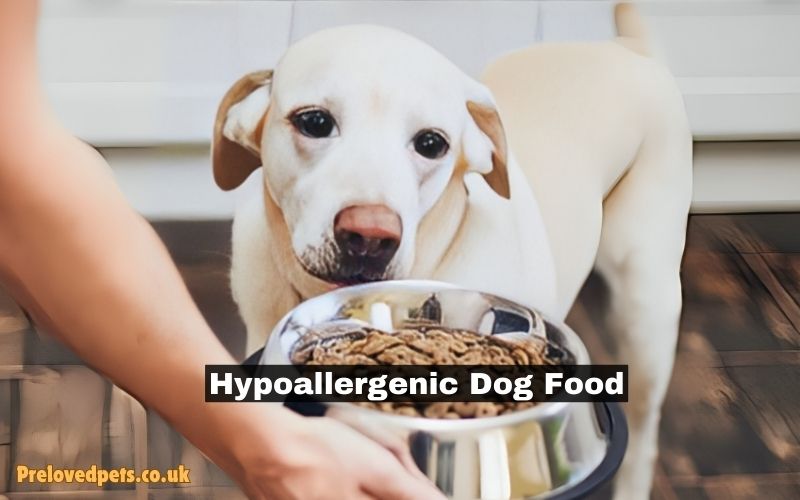With an increasing number of pet owners becoming aware of their pets’ dietary needs and allergies, hypoallergenic dog food has become a topic of significant interest. This article aims to provide a thorough understanding of hypoallergenic dog food, its benefits, the ingredients typically included and excluded, and how to choose the right hypoallergenic diet for your dog.
Understanding Canine Allergies
What Are Canine Allergies?
Just like humans, dogs can suffer from allergies. These can be triggered by various environmental factors such as pollen, dust mites, or specific ingredients in their food. Common symptoms of allergies in dogs include:
- Itchy skin or ears: Dogs with food allergies often experience persistent itching, particularly around the ears, paws, and face.
- Gastrointestinal issues: Symptoms like vomiting, diarrhea, and gas are common when a dog has a food allergy.
- Chronic ear infections: Frequent ear infections that are resistant to treatment may indicate a food allergy.
- Excessive licking or chewing of paws: Dogs with allergies may constantly lick or chew their paws due to itching and discomfort.
Food allergies can develop at any age, and identifying the specific allergen can be challenging, requiring a methodical approach.
Food Allergies vs. Food Intolerances
It’s essential to distinguish between food allergies and food intolerances. Food allergies involve an immune response to a specific protein in the diet, whereas food intolerances typically result in gastrointestinal issues without an immune response. Common allergens in dog food include beef, dairy, wheat, egg, chicken, lamb, soy, pork, rabbit, and fish.
- Food Allergies: The dog’s immune system mistakenly identifies a protein as harmful, leading to an allergic reaction. This can result in symptoms like itching, swelling, and gastrointestinal upset.
- Food Intolerances: These are non-immunological responses, often resulting in digestive issues such as diarrhea or vomiting. Common causes include lactose intolerance or sensitivity to certain additives or preservatives.
Understanding the difference between allergies and intolerances is crucial for managing your dog’s health effectively.
What is Hypoallergenic Dog Food?
Definition
Hypoallergenic dog food is formulated to reduce the risk of allergic reactions. It typically avoids common allergens and may include novel protein sources and easily digestible ingredients. Some hypoallergenic diets also include hydrolyzed proteins, which are broken down into smaller pieces that are less likely to trigger an allergic response.
Types of Hypoallergenic Dog Food
- Limited Ingredient Diets (LIDs): These diets contain a minimal number of ingredients to reduce the risk of an allergic reaction. They usually feature a single protein source and a single carbohydrate source. Limited ingredient diets simplify the food formula to make it easier to identify and eliminate allergens.
- Novel Protein Diets: These diets use proteins that are not commonly found in regular dog food, such as venison, duck, or kangaroo. The goal is to introduce a protein that the dog’s immune system has not previously encountered, thereby reducing the likelihood of an allergic response.
- Hydrolyzed Protein Diets: The proteins in these diets are broken down into smaller fragments, making them less likely to be recognized by the dog’s immune system as allergens. Hydrolyzed proteins can be so small that they do not trigger an allergic reaction.
Each type of hypoallergenic dog food serves a specific purpose and can be recommended based on the dog’s specific allergies and sensitivities.
See Also: Years Dog Food
Ingredients in Hypoallergenic Dog Food
Commonly Used Ingredients
- Novel Proteins: Proteins that are not commonly used in traditional dog foods, such as venison, duck, kangaroo, and rabbit. These proteins are less likely to cause allergic reactions since dogs have not been widely exposed to them.
- Novel Carbohydrates: Carbohydrates like sweet potatoes, peas, and lentils are used instead of common allergens like wheat and corn. These ingredients are not only hypoallergenic but also provide essential nutrients and fiber.
- Hydrolyzed Proteins: These proteins are broken down into smaller peptides to prevent the immune system from recognizing them as allergens. This process makes them easier to digest and less likely to cause an allergic reaction.
- Omega-3 and Omega-6 Fatty Acids: These help reduce inflammation and support skin health. Sources include fish oil and flaxseed oil, which promote a healthy coat and skin.
Ingredients Typically Avoided
- Common Proteins: Beef, chicken, lamb, and pork are often avoided because they are frequent causes of food allergies in dogs.
- Grains: Wheat, corn, and soy are common allergens and are typically excluded from hypoallergenic diets. These grains can also contribute to gastrointestinal issues in some dogs.
- Dairy Products: Milk, cheese, and other dairy products are avoided due to their allergenic potential and the fact that many dogs are lactose intolerant.
- Artificial Additives: Preservatives, colorings, and flavorings are often omitted from hypoallergenic dog food to reduce the risk of adverse reactions.
Understanding these ingredients and their role in hypoallergenic diets can help pet owners make informed choices for their dogs.
Benefits of Hypoallergenic Dog Food
Reduced Allergic Reactions
The primary benefit of hypoallergenic dog food is the reduction of allergic reactions. By eliminating common allergens, dogs are less likely to experience symptoms like itching, gastrointestinal upset, and chronic ear infections. This leads to a healthier, happier pet and reduces the need for medical treatments.
Improved Digestion
Many hypoallergenic dog foods contain easily digestible ingredients, which can lead to better digestion and nutrient absorption. This can result in improved overall health and vitality. Ingredients like sweet potatoes and peas are not only hypoallergenic but also gentle on the digestive system.
Enhanced Skin and Coat Health
Hypoallergenic diets often include ingredients that promote healthy skin and a shiny coat, such as omega-3 and omega-6 fatty acids. Reduced allergic reactions also mean less itching and scratching, leading to healthier skin. A diet rich in essential fatty acids can help alleviate dry, flaky skin and improve the coat’s luster.
Better Quality of Life
For dogs suffering from food allergies, switching to a hypoallergenic diet can significantly improve their quality of life. Reduced symptoms mean they can enjoy their daily activities without discomfort. Owners will also notice fewer veterinary visits and lower medical costs associated with managing allergic reactions.
How to Choose the Right Hypoallergenic Dog Food
Consultation with a Veterinarian
Before making any changes to your dog’s diet, it’s essential to consult with a veterinarian. They can help identify the allergens causing the issues and recommend a suitable hypoallergenic diet. In some cases, an elimination diet may be necessary to pinpoint the specific allergens. This involves feeding the dog a diet free from suspected allergens and then gradually reintroducing them one by one.
Ingredient List
When selecting a hypoallergenic dog food, carefully read the ingredient list. Look for foods with limited ingredients and novel protein sources. Avoid foods with common allergens and unnecessary fillers. The fewer the ingredients, the easier it is to identify potential allergens and ensure the diet is suitable for your dog.
Trial and Observation
Once you’ve selected a hypoallergenic dog food, introduce it gradually to your dog’s diet. Monitor your dog closely for any changes in symptoms. It may take several weeks to see significant improvements. Keep a journal of your dog’s reactions, noting any changes in behavior, digestion, and skin condition.
High-Quality Brands
Choose reputable brands known for their high-quality ingredients and strict manufacturing processes. Brands that conduct feeding trials and have veterinary nutritionists on staff are often more reliable. Look for certifications and quality seals from organizations like the Association of American Feed Control Officials (AAFCO).
Popular Hypoallergenic Dog Food Brands
- Hill’s Prescription Diet: Offers a variety of hypoallergenic options, including novel protein and hydrolyzed protein diets. These diets are often recommended by veterinarians and are specifically formulated for dogs with food sensitivities.
- Royal Canin Veterinary Diet: Known for their hydrolyzed protein formulas and limited ingredient diets. They provide tailored nutrition based on specific health needs, including allergies.
- Blue Buffalo Basics: Provides limited ingredient diets with novel protein sources. Blue Buffalo focuses on natural ingredients and avoids artificial additives.
- Natural Balance L.I.D.: Offers a range of limited ingredient diets with various protein options. Their formulas are designed to minimize the risk of allergic reactions.
- Wellness Simple: Features limited ingredient diets focusing on a single protein source and easily digestible carbohydrates. Wellness Simple is known for its high-quality ingredients and balanced nutrition.
Homemade Hypoallergenic Dog Food
Benefits of Homemade Diets
Preparing hypoallergenic dog food at home allows for complete control over the ingredients, ensuring that your dog isn’t exposed to any allergens. It also allows for customization based on your dog’s specific needs and preferences. Homemade diets can be especially beneficial for dogs with multiple allergies or sensitivities.
Essential Nutrients
When preparing homemade dog food, it’s crucial to ensure that the diet is balanced and includes all essential nutrients. This typically involves:
- Protein: A novel protein source such as venison, duck, or fish.
- Carbohydrates: Easily digestible sources like sweet potatoes or quinoa.
- Fats: Healthy fats such as fish oil or coconut oil.
- Vitamins and Minerals: Supplementing the diet with a comprehensive multivitamin designed for dogs.
Ensuring a balanced diet is critical to avoid nutritional deficiencies that can lead to other health issues.
Recipes
Here are a few simple hypoallergenic dog food recipes:
Venison and Sweet Potato
Ingredients:
- 1 pound ground venison
- 2 cups cooked and mashed sweet potatoes
- 1 cup cooked peas
- 1 tablespoon fish oil
Instructions:
- Cook the venison thoroughly.
- Mix the cooked venison with the mashed sweet potatoes and peas.
- Add the fish oil and mix well.
- Allow the food to cool before serving.
Duck and Quinoa
Ingredients:
- 1 pound ground duck
- 2 cups cooked quinoa
- 1 cup cooked spinach
- 1 tablespoon coconut oil
Instructions:
- Cook the duck thoroughly.
- Mix the cooked duck with the cooked quinoa and spinach.
- Add the coconut oil and mix well.
- Allow the food to cool before serving.
Consultation with a Veterinary Nutritionist
When preparing homemade hypoallergenic dog food, it’s highly recommended to consult with a veterinary nutritionist. They can help ensure that the diet is nutritionally balanced and appropriate for your dog’s specific needs. A veterinary nutritionist can also help customize recipes and provide guidance on portion sizes and supplementation.
Common Myths About Hypoallergenic Dog Food
Myth 1: Hypoallergenic Dog Food is Just a Marketing Gimmick
While some brands may use the term “hypoallergenic” as a marketing tool, genuine hypoallergenic dog food is formulated to reduce the risk of allergic reactions. Choosing reputable brands and consulting with a veterinarian can help you find effective hypoallergenic options. It’s important to understand that hypoallergenic dog food is specifically designed to address and manage food allergies.
Myth 2: Grain-Free Diets Are Always Hypoallergenic
Grain-free diets are not necessarily hypoallergenic. While some grains can cause allergies in dogs, grain-free diets may still contain other common allergens like chicken or beef. It’s essential to focus on the specific ingredients rather than just whether a diet is grain-free. Some dogs may thrive on grain-inclusive diets if they are free from other allergens.
Myth 3: All Natural Diets Are Hypoallergenic
Natural ingredients can still be allergens. Hypoallergenic dog food focuses on avoiding specific allergens, regardless of whether the ingredients are natural or not. Natural diets are beneficial for overall health, but they must be tailored to avoid allergens for allergic dogs.
Conclusion
Hypoallergenic dog food can significantly improve the quality of life for dogs suffering from food allergies. By understanding the common allergens, ingredients used in hypoallergenic diets, and how to choose the right food, pet owners can make informed decisions to support their dogs’ health and well-being.
Consulting with a veterinarian, carefully reading ingredient lists, and considering reputable brands are essential steps in selecting an appropriate hypoallergenic diet. Additionally, for those interested in preparing homemade dog food, ensuring a balanced diet and consulting with a veterinary nutritionist is crucial.
By providing a hypoallergenic diet, pet owners can help their dogs enjoy a happier, healthier life free from the discomfort of food allergies. The journey to finding the right diet may require patience and persistence, but the benefits for your dog’s health and quality of life are well worth the effort.




